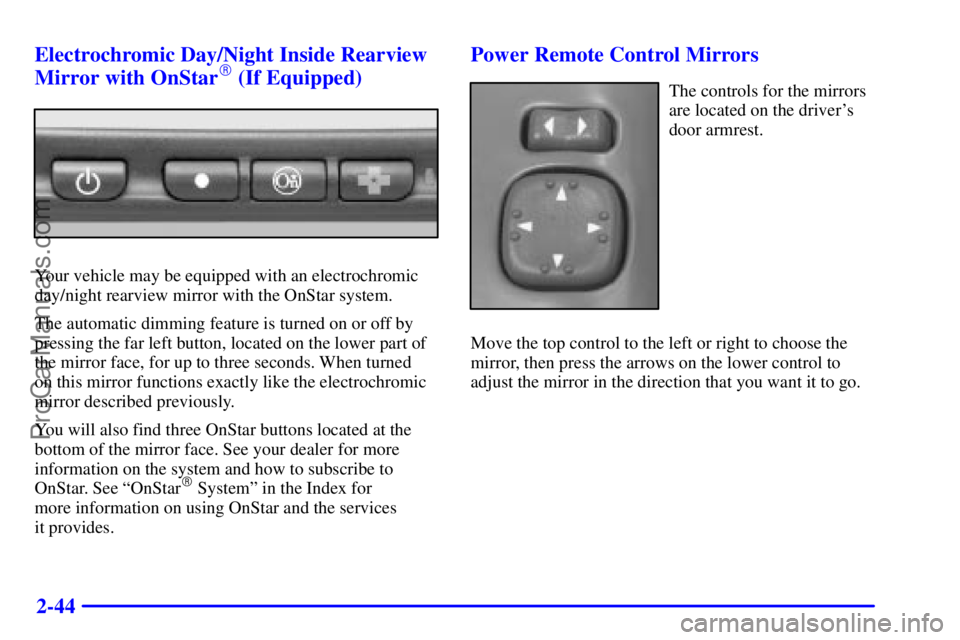Page 108 of 371

2-43
Mirrors
Electrochromic Day/Night Inside
Rearview Mirror
This mirror automatically changes to reduce glare from
headlamps behind you. A photocell on the back of the
mirror senses when it is becoming dark outside. Another
photocell built into the mirror surface senses when
headlamps are behind you.At night, when the glare is too high, the mirror will
gradually darken to reduce glare (this change may
take a few seconds). The mirror will return to its clear
daytime state when the glare is reduced. The mirror will
also return to its clear daytime state when the vehicle is
put into REVERSE (R).
Press the AUTO button at the base of the mirror to turn
on the automatic feature. The button has an indicator
light to show it is on. Press the OFF button to turn the
automatic feature off.
Time Delay
The automatic mirror has a time delay feature which
prevents unnecessary switching from the night back to
the day position. This delay prevents rapid changing of
the mirror as you drive under lights and through traffic.
Cleaning the Photocells
Use a cotton swab and glass cleaner to clean the
photocells when necessary.
ProCarManuals.com
Page 109 of 371

2-44 Electrochromic Day/Night Inside Rearview
Mirror with OnStar
� (If Equipped)
Your vehicle may be equipped with an electrochromic
day/night rearview mirror with the OnStar system.
The automatic dimming feature is turned on or off by
pressing the far left button, located on the lower part of
the mirror face, for up to three seconds. When turned
on this mirror functions exactly like the electrochromic
mirror described previously.
You will also find three OnStar buttons located at the
bottom of the mirror face. See your dealer for more
information on the system and how to subscribe to
OnStar. See ªOnStar
� Systemº in the Index for
more information on using OnStar and the services
it provides.
Power Remote Control Mirrors
The controls for the mirrors
are located on the driver's
door armrest.
Move the top control to the left or right to choose the
mirror, then press the arrows on the lower control to
adjust the mirror in the direction that you want it to go.
ProCarManuals.com
Page 110 of 371
2-45 Convex Outside Mirror
A convex mirror's surface is curved so you can see more
from the driver's seat.
CAUTION:
A convex mirror can make things (like other
vehicles) look farther away than they really
are. If you cut too sharply into the right or left
lane, you could hit a vehicle. Check your inside
mirror or glance over your shoulder before
changing lanes.
Heated Outside Rearview Mirrors
When you operate the rear window defogger, a defogger
also warms the heated driver's and passenger's outside
rearview mirrors to help clear them of ice, snow and
condensation. See ªRear Window Defoggerº in the
Index for more information.
Electrochromic Rearview Outside Mirror
The driver's side outside mirror will adjust for the glare
of the headlamps behind you. See ªElectrochromic
Day/Night Inside Rearview Mirrorº earlier in this section.
ProCarManuals.com
Page 194 of 371

4-28
Driving at Night
Night driving is more dangerous than day driving. One
reason is that some drivers are likely to be impaired
-- by
alcohol or drugs, with night vision problems, or by fatigue.
Here are some tips on night driving.
�Drive defensively.
�Don't drink and drive.�Adjust your inside rearview mirror to reduce the
glare from headlamps behind you.
�Since you can't see as well, you may need to
slow down and keep more space between you and
other vehicles.
�Slow down, especially on higher speed roads. Your
headlamps can light up only so much road ahead.
�In remote areas, watch for animals.
�If you're tired, pull off the road in a safe place
and rest.
No one can see as well at night as in the daytime. But as
we get older these differences increase. A 50
-year-old
driver may require at least twice as much light to see the
same thing at night as a 20
-year-old.
What you do in the daytime can also affect your night
vision. For example, if you spend the day in bright
sunshine you are wise to wear sunglasses. Your eyes
will have less trouble adjusting to night. But if you're
driving, don't wear sunglasses at night. They may cut
down on glare from headlamps, but they also make a lot
of things invisible.
ProCarManuals.com